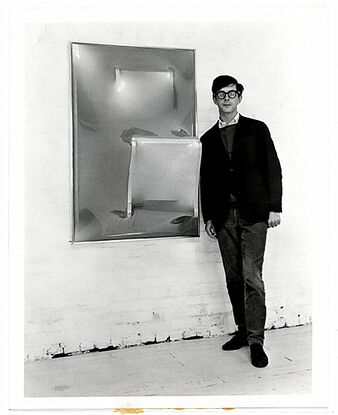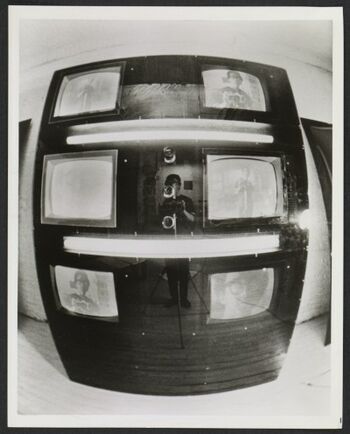Difference between revisions of "Les Levine"
m (Text replacement - "imagesize = 342px" to "imagesize = 338px") |
|||
| Line 49: | Line 49: | ||
* Barbara Cavaliere, et al., ''Limited Editions of Hand Printed Etchings by Les Levine'', New York: Artist Profusions, 1979, 64 pp. | * Barbara Cavaliere, et al., ''Limited Editions of Hand Printed Etchings by Les Levine'', New York: Artist Profusions, 1979, 64 pp. | ||
* Tom Holert, "Information Society: The Art of Les Levine", ''Artforum'', May 2013. [https://www.artforum.com/print/201305/information-society-the-art-of-les-levine-40457] | * Tom Holert, "Information Society: The Art of Les Levine", ''Artforum'', May 2013. [https://www.artforum.com/print/201305/information-society-the-art-of-les-levine-40457] | ||
| + | *Corinna Kirsch, "Les Levine: Disposable Art, Media, and Technology, 1964–1971," PhD diss., Stony Brook University, Stony Brook, NY, 2021. | ||
| + | [https://www.proquest.com/docview/2638961998?] | ||
==Links== | ==Links== | ||
Revision as of 20:47, 16 October 2022
 Levine with one of his vacuum formed sculptures, 1966. | |
| Born |
October 6, 1935 Dublin, Ireland |
|---|---|
| Web | UbuWeb, CCCA, Wikipedia-DE |
| Collections | IMMA 115, NGC Ottawa 58, MoMA 36, Walker 2, MAMCS Strasbourg 2, LIMA 1, Whitney 1 |
Les Levine (1935, Dublin) is a pioneer of video and media art, living in New York City.
Levine studied at the Central School of Arts and Crafts, London, before moving to Toronto in 1958, where he continued his studies at the New School of Art. His artistic practice has been explored through various means including painting, sculpture, installation, performance work, mail art and artists’ books.
Moving to New York in the 1960s, he became a leading conceptual art figure, intersecting art and life in a variety of projects such as Levine’s Restaurant, 1969 and the conceptual museum he invented in 1970 called the Museum of Mott Art, Inc. He regards himself as a media sculptor, “mould(ing) media the way others would mould matter.” In the 1960s, Levine was one of the first artists to work with video and television. His work was to become a precursor to the new generation of experimental artists who were exploring the possibilities of the moving image including Dan Graham, Gary Hill and Bruce Nauman. Since the 1980s Levine has become particularly recognised for his billboard works in which he subverts the language of mass advertising to interrogate social and political problems.
Solo exhibitions include the Walker Art Centre, Minneapolis; the Museum of Modern Art, New York; National Gallery of Victoria Melbourne; Albright Knox Gallery, Buffalo; and the Vancouver Art Gallery, Vancouver. (Source)
Writings
- "The Disposable Transient Environment", Artscanada 25:1 (Apr 1968), pp 27-30. [1]
- "Red Tape", Design Quarterly 78-79 (1970), pp 37-41. [2]
- "The Information Fallout", in Conceptual Decorative: Prints by Les Levine, 1965-1970, Ottawa: National Gallery of Canada, 1971. Adapted from a paper written for a catalogue to the Recorded Activities (1970).
- "What Can the Government of Canada Do For You?", Impulse 4:3 (Fall 1975), pp 1-20. [3]
- "Les Levine: We Are Still Alive", Parachute 2 (Jan-Mar 1976), pp 23-26. [4]
- "We Are Still Alive", MayDay 1:2 (1976), pp 8-19. [5]
- "One-Gun Video Art", in Video by Artists, ed. Peggy Gale, Toronto: Art Metropole, 1976, pp 177-185; repr. in New Artists Video: A Critical Anthology, ed. Gregory Battcock, New York: E.P. Dutton, 1978, pp 76-94.
- Media: The Bio-Tech Rehearsal for Leaving the Body, Calgary, Alta: Alberta College of Art Gallery, 1979, 112 pp. A collection of essays, poems, and documentation. Extract. [6]
Interviews
- Thelma R. Newman, "The Artist Speaks: Les Levine", Art in America 57:6 (Nov-Dec 1969), pp 86-93. [7]
- Davidson Gigliotti, "Les Levine Interview", The Early Video Project, 2000. Recorded 9 Dec 1999.
Catalogues
- Conceptual Decorative: Prints by Les Levine, 1965-1970 / Conceptuel decoratif: estampes de Les Levine, 1965-1970, Ottawa: National Gallery of Canada, 1971, 24 pp. [8] [9]
- Les Levine Copies Everyone, Toronto: Isaacs Gallery, 1973, 156 pp. [10] [11]
- Les Levine, Vancouver: Vancouver Art Gallery, c1974, 32 pp. Texts by Gregory Battcock, David Bourdon, Jack Burnham, John Perreault, Catherine Levine. [12]
- Art Can See - Medienskulptur / Media Sculpture, ed. Johann-Karl Schmidt, Hatje Cantz, 1997, 180 pp. With texts by Isabel Greschat, Thomas McEvilley, and Johann-Karl Schmidt. (English)/(German) [13]
Literature
- Jill Johnston, "Liking Things for What They Are", Canadian Art 23:3 (Jul 1966), pp 15-17. [14]
- Joanna Marsden Woods, "Le Canada a la Biennale de Paris: Les Levine", Vie des Arts 56 (Autumn 1969), pp 40-43. (French)
- Gene Youngblood, "Les Levine: Iris", section in Youngblood, Expanded Cinema, New York: Dutton, 1970, pp 338-341, HTML.
- Jack Burnham, "Les Levine: Business as Usual", Artforum International 8:8 (Apr 1970), pp 40-43; repr. in Burnham, The Great Western Salt Works, New York: G. Braziller, 1974, pp 39-46. [15]
- Jack Burnham, "Les Levine and the Troubles", Arts Magazine 47:6 (Apr 1973), pp 56-59. [16]
- Axel Hecht, "Les Levine", Kunstforum 1: "Kommunikations-Objekte", Cologne, Mar-Apr 1973. [17] (German)
- Jacqueline Fry, "'We Are Still Alive' de Les Levine ou 'La provocation ratee'", Parachute 3 (Apr-Jun 1976), pp 19-22. (French) [18]
- Barbara Cavaliere, et al., Limited Editions of Hand Printed Etchings by Les Levine, New York: Artist Profusions, 1979, 64 pp.
- Tom Holert, "Information Society: The Art of Les Levine", Artforum, May 2013. [19]
- Corinna Kirsch, "Les Levine: Disposable Art, Media, and Technology, 1964–1971," PhD diss., Stony Brook University, Stony Brook, NY, 2021.
